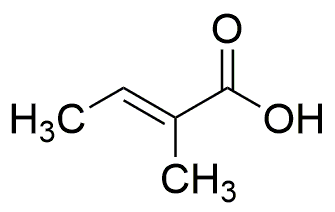Tiglic acid is widely utilized in research focused on:
- Flavoring and Fragrance Industry: This compound is used as a flavoring agent in food products and as a fragrance component in perfumes, providing a unique scent profile that enhances product appeal.
- Pharmaceuticals: Tiglic acid serves as an intermediate in the synthesis of various pharmaceuticals, contributing to the development of medications with improved efficacy and reduced side effects.
- Polymer Production: It is employed in the production of specialty polymers, which are used in coatings and adhesives, offering enhanced durability and performance compared to traditional materials.
- Biochemical Research: Researchers utilize tiglic acid in studies related to metabolic pathways and enzyme activity, helping to advance our understanding of biochemical processes.
- Agricultural Applications: This compound is explored for its potential use in developing natural herbicides, providing an eco-friendly alternative to synthetic chemicals in crop management.
General Information
Properties
Safety and Regulations
Applications
Tiglic acid is widely utilized in research focused on:
- Flavoring and Fragrance Industry: This compound is used as a flavoring agent in food products and as a fragrance component in perfumes, providing a unique scent profile that enhances product appeal.
- Pharmaceuticals: Tiglic acid serves as an intermediate in the synthesis of various pharmaceuticals, contributing to the development of medications with improved efficacy and reduced side effects.
- Polymer Production: It is employed in the production of specialty polymers, which are used in coatings and adhesives, offering enhanced durability and performance compared to traditional materials.
- Biochemical Research: Researchers utilize tiglic acid in studies related to metabolic pathways and enzyme activity, helping to advance our understanding of biochemical processes.
- Agricultural Applications: This compound is explored for its potential use in developing natural herbicides, providing an eco-friendly alternative to synthetic chemicals in crop management.
Documents
Safety Data Sheets (SDS)
The SDS provides comprehensive safety information on handling, storage, and disposal of the product.
Product Specification (PS)
The PS provides a comprehensive breakdown of the product’s properties, including chemical composition, physical state, purity, and storage requirements. It also details acceptable quality ranges and the product's intended applications.
Certificates of Analysis (COA)
Search for Certificates of Analysis (COA) by entering the products Lot Number. Lot and Batch Numbers can be found on a product’s label following the words ‘Lot’ or ‘Batch’.
*Catalog Number
*Lot Number
Certificates Of Origin (COO)
This COO confirms the country where the product was manufactured, and also details the materials and components used in it and whether it is derived from natural, synthetic, or other specific sources. This certificate may be required for customs, trade, and regulatory compliance.
*Catalog Number
*Lot Number
Safety Data Sheets (SDS)
The SDS provides comprehensive safety information on handling, storage, and disposal of the product.
DownloadProduct Specification (PS)
The PS provides a comprehensive breakdown of the product’s properties, including chemical composition, physical state, purity, and storage requirements. It also details acceptable quality ranges and the product's intended applications.
DownloadCertificates of Analysis (COA)
Search for Certificates of Analysis (COA) by entering the products Lot Number. Lot and Batch Numbers can be found on a product’s label following the words ‘Lot’ or ‘Batch’.
*Catalog Number
*Lot Number
Certificates Of Origin (COO)
This COO confirms the country where the product was manufactured, and also details the materials and components used in it and whether it is derived from natural, synthetic, or other specific sources. This certificate may be required for customs, trade, and regulatory compliance.


